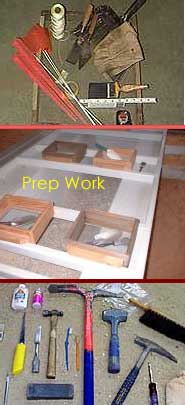
|
 |
||||
Fossils within the field jacket are situated in a matrix or rock, ensuring it doesn’t move during transport.
In the lab the jacket is cut open with a saw. Using picks the rock layer (matrix) is removed to reveal the fossil. For finer work to remove hardened minerals from the outside of the fossil, microscopes and magnifying glasses are used in conjunction with an air scribe. The air scribe is a movable point that blows out air to remove finer material on the specimen.
Some specimens may require consolidant. The consolidant the MDM uses is B-76. This powder compound is dissolved in acetone for different consistencies. Application is primarily in the field and left to harden before removal. While preparing some fossils consolidant may be used inside the lab but must be left to harden over night. A consolidant acts like a glue from the inside out. The solution seeps into the fossil and begins hardening from the inside to the outside. This provides support and rigidity to the fossil. The fossils are prepared in such a way to leave them in their original state as much as possible.
Once prepared the fossils are ready for storage or display use.